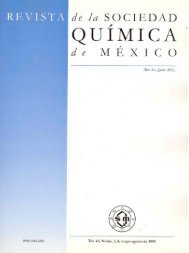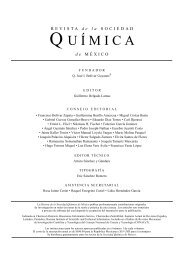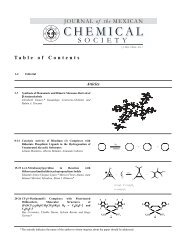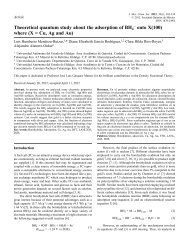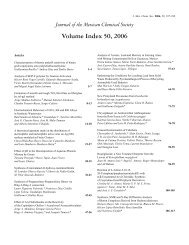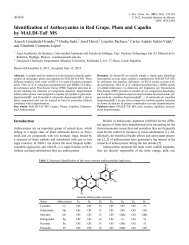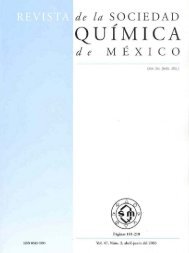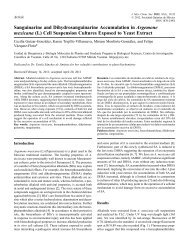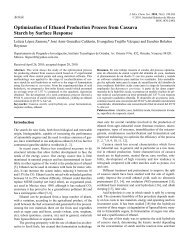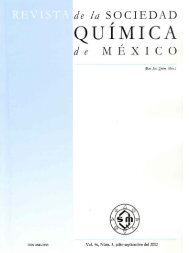SMQ-V043 N-001_ligas_size.pdf - Journal of the Mexican Chemical ...
SMQ-V043 N-001_ligas_size.pdf - Journal of the Mexican Chemical ...
SMQ-V043 N-001_ligas_size.pdf - Journal of the Mexican Chemical ...
Create successful ePaper yourself
Turn your PDF publications into a flip-book with our unique Google optimized e-Paper software.
Revista de la Sociedad Química de México, Vol. 43, Núm. 1 (1999) 24-29<br />
Revisión<br />
An Integrated, Holistic Experimental and Theoretical Approach<br />
Applied to <strong>the</strong> Derivation <strong>of</strong> <strong>the</strong> 3D Structure <strong>of</strong> Bovine Amelogenin<br />
implicated in Amelogenesis imperfecta, a Molecular Disease<br />
Characterized by a Single Point Mutation<br />
V. Renugopalakrishnan l, 2 *, R. Garduño-Juárez 3 , Juan Carlos Hernández Guerrero 4 ,<br />
Patricia N. Casillas Lavín 4 and K. Ilangovan 5<br />
1 Harvard Medical School, Harvard University, 423 Av., Boston, MA 02115, USA, Fax +1.617.738.4960; 2 Instituto de Química,<br />
Universidad Nacional Autónoma de México, Circuito Exterior, Ciudad Universitaria, Coyoacán, 04510 México DF, México. Fax<br />
+52-5616-2217, email: renu@servidor.unam.mx; 3 Centro de Ciencias Físicas, Universidad Nacional Autónoma de México,<br />
62210 Cuernavaca, Morelos, México; 4 Facultad de Odontología, Universidad Nacional Autónoma de México, 04510 México DF,<br />
México; 5 Instituto de Ingeniería, Universidad Nacional Autónoma de México, 04510 México DF, México.<br />
Resumen. La amelogenina, una fosfoproteína de 170 residuos, de<br />
~19kDa, extracelular e hidr<strong>of</strong>óbica, con una estructura elipsoidal,<br />
secretada por los ameloblastes dentales bovinos, contiene una estructura<br />
primaria única comparada con otras proteínas de mamíferos de<br />
estructura primaria conocida. Se caracteriza por una proporción alta<br />
de Leu, His, Met, Gln, y Pro, y también contiene un residuo de Ser 16<br />
fosforilado. Se revisan los estudios de ingeniería genética combinados<br />
con investigación en biología estructural. La estructura tridimensional<br />
de la amelogenina dental de bovinos ha sido el tema de investigación<br />
del autor principal en la Escuela Médica de Harvard desde<br />
1984, empleando aproximaciones teóricas y experimentales<br />
integradas. Estas aproximaciones se describen mediante un diagrama<br />
de flujo. Su estructura tridimensional contiene numerosos giros β-,<br />
una estructura espiral β-, segmentos de hojas β-aislados, y tiene un<br />
contenido bajo α-helicoidal. Los mutantes de la amelogenina y<br />
algunos fragmentos sintéticos tienen potencial clínico en el tratamiento<br />
de la Amelogenesis imperfecta, una enfermedad dental prevalente<br />
en México.<br />
Palabras clave: RMN 3D, IR-TF, Raman, DC, Flourescencia, Síntesis<br />
de polipéptidos, Enfermedad molecular, Dinámica molecular, Canal de<br />
iones, M179 resíduo recombinante, amelogenina, estructura secundaria.<br />
Introduction<br />
Abstract. Bovine Amelogenin, a 170-residue, ~19 kDa extracellular,<br />
hydrophobic, phosphoprotein with an overall ellipsoidal shape,<br />
secreted by ameloblasts from bovine tooth enamel, contains a primary<br />
structure which is unique in comparison to o<strong>the</strong>r known primary<br />
structures <strong>of</strong> mammalian proteins. lt is characterized by a large proportion<br />
<strong>of</strong> Leu, His, Met, Gln, and Pro residues and also contains a<br />
single phosphorylated Ser16 residue. Genetic engineering studies<br />
combined with structural biological research are discussed in this<br />
review. 3D structure <strong>of</strong> bovine tooth amelogenin has been <strong>the</strong> focus<br />
<strong>of</strong> research by <strong>the</strong> principal author at Harvard Medical School since<br />
1984 using an integrated experimental and <strong>the</strong>oretical approach. A<br />
flow sheet describes <strong>the</strong> general strategy for such an integrated<br />
approach. Its 3D structure contains numerous β-turns, a β-spiral<br />
structure, isolated β-sheet segments, and is low in α-helical content.<br />
Amelogenin mutants and syn<strong>the</strong>tic fragments have potencial clinical<br />
use in fighting amelogenesis imperfecta, a dental disease which is<br />
prevalent in Mexico.<br />
Key Words: 3D NMR, FT-IR, Raman, CD, Time-resolved<br />
Fluorescence, Polypeptide syn<strong>the</strong>sis, Molecular Disease, Molecular<br />
Dynamics, Ion Channel, Ml79-a 179 residue recombinant mouse<br />
amelogenin, Secondary Structure.<br />
Structural biology <strong>of</strong> proteins has made significant advances<br />
in <strong>the</strong> last two decades, propelled by multi-nuclear 2D and 3D<br />
NMR spectroscopy [l], X-ray and Neutron diffraction Fourier<br />
transform infrared (FT-IR) [2], laser Raman spectroscopy<br />
(LRS), small angle neutron scattering.(SANS), time-resolved<br />
flurorescence spectroscopy, molecular mechanics-dynamics<br />
approach [3], solid-phase peptide syn<strong>the</strong>sis and <strong>the</strong> capability<br />
to produce monoclonally pure proteins by expression <strong>of</strong><br />
appropriate cDNA’s in a bacterial cell e.g. E. coli and site-specific<br />
mutagenesis to syn<strong>the</strong><strong>size</strong> mutant proteins. Structural<br />
biology and molecular biology have <strong>the</strong>refore become interdependent.<br />
Despite all <strong>the</strong>se impressive technical developments,<br />
<strong>the</strong> solution-phase structure <strong>of</strong> proteins with M r > 30<br />
kDa by heteronuclear multi-dimensional NMR [1] continues<br />
to pose formidable challenges especially in <strong>the</strong> assignment <strong>of</strong><br />
proton resonances. FT-IR and LRS have no limitations on <strong>the</strong><br />
M r <strong>of</strong> proteins which can be investigated using <strong>the</strong>se two<br />
methods. The development <strong>of</strong> 2D Heterospectral IR-Raman<br />
[4], is a significant advance <strong>of</strong> immense value to protein structural<br />
biology. In terms <strong>of</strong> <strong>the</strong> structural information content,<br />
NMR spectroscopy rivals with X-ray and neutron diffraction.<br />
In <strong>the</strong> case <strong>of</strong> membrane proteins and proteins that are stubborn<br />
to crystallization due to <strong>the</strong>ir mobility <strong>of</strong> <strong>the</strong> glycosamino<br />
glycan (GAG) and lipid side chains [1] e.g. glycoproteins, pro-




